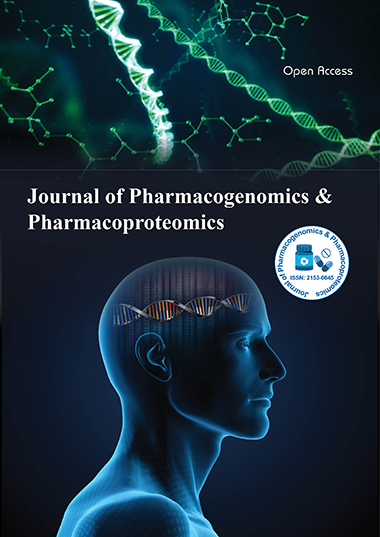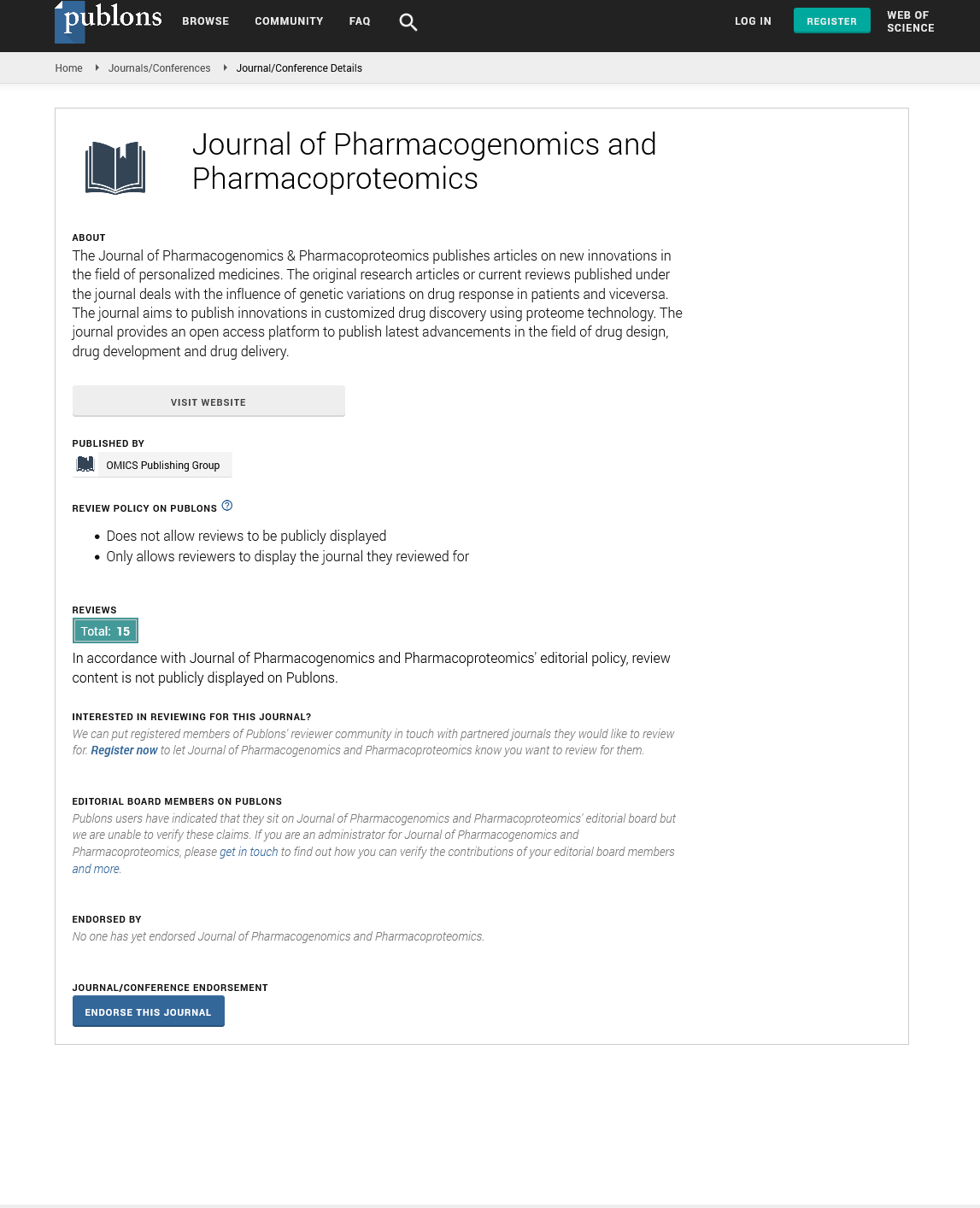Indexed In
- Open J Gate
- Genamics JournalSeek
- Academic Keys
- JournalTOCs
- ResearchBible
- Electronic Journals Library
- RefSeek
- Hamdard University
- EBSCO A-Z
- OCLC- WorldCat
- Proquest Summons
- SWB online catalog
- Virtual Library of Biology (vifabio)
- Publons
- MIAR
- Euro Pub
- Google Scholar
Useful Links
Share This Page
Journal Flyer

Open Access Journals
- Agri and Aquaculture
- Biochemistry
- Bioinformatics & Systems Biology
- Business & Management
- Chemistry
- Clinical Sciences
- Engineering
- Food & Nutrition
- General Science
- Genetics & Molecular Biology
- Immunology & Microbiology
- Medical Sciences
- Neuroscience & Psychology
- Nursing & Health Care
- Pharmaceutical Sciences
Short Communication - (2024) Volume 15, Issue 4
Chemotherapeutic Drugs and DNA Damage Degradation in the Context of Antiretroviral Drug Resistance
Thibault Kalim*Received: 25-Nov-2024, Manuscript No. JPP-24-27920 ; Editor assigned: 29-Nov-2024, Pre QC No. JPP-24-27920 (PQ); Reviewed: 16-Dec-2024, QC No. JPP-24-27920 ; Revised: 24-Dec-2024, Manuscript No. JPP-24-27920 (R); Published: 31-Dec-2024, DOI: 10.35248/2153-0645.24.15.116
Description
Antiretroviral drugs (ARVs) have revolutionized the treatment of Human Immunodeficiency Virus (HIV), significantly improving the lifespan and quality of life for individuals living with the virus. These drugs work by targeting key enzymes involved in the viral life cycle, such as reverse transcriptase, protease and integrase. Despite their effectiveness, a significant challenge in HIV treatment is the emergence of drug resistance. Resistance occurs when the virus adapts and evades the effects of ARVs, often due to mutations in viral genes. Although the use of combination therapies has reduced the occurrence of resistance, new approaches to address this challenge continue to be explored. One such approach involves the modulation of DNA damage repair mechanisms and how chemotherapeutic agents might influence the degradation of ARVs. This manuscript discusses the potential role of chemotherapeutic drugs in the degradation of ARVs through DNA damage pathways and the implications for HIV therapy [1-3].
Mechanisms of antiretroviral drug action are before delving into the role of chemotherapeutic drugs, it is essential to understand how ARVs work. These drugs target various stages of the HIV life cycle, preventing the virus from replicating within the host. Nucleoside Reverse Transcriptase Inhibitors (NRTIs) these mimic the building blocks of viral RNA and inhibit reverse transcriptase, the enzyme responsible for converting viral RNA into DNA. Non-Nucleoside Reverse Transcriptase Inhibitors (NNRTIs) these bind directly to reverse transcriptase and inhibit its action. Protease Inhibitors (PIs) these inhibit the viral protease enzyme, preventing the maturation of new viral particles. Integrate Strand Transfer Inhibitors (INSTIs) these block integrate, an enzyme that facilitates the integration of viral DNA into the host genome. Entry inhibitors block the virus from entering the host cell.
Although ARVs are highly effective, long-term use can lead to the development of drug resistance, a phenomenon that can be driven by mutations in the viral genome that alter the structure or function of the target enzymes. Resistance to ARVs leads to reduced efficacy, requiring the use of second-line or alternative drug regimens, which are often more complex and have a higher side-effect profile. DNA damage occurs naturally due to various factors, including oxidative stress, radiation and chemical agents. The cellular DNA Damage Response (DDR) is a collection of cellular mechanisms that detect and repair DNA damage to maintain genome integrity. DDR pathways include the activation of sensor proteins, transducers and effectors that work to repair DNA damage or induce apoptosis if the damage is irreparable. HIV infection also triggers a DNA damage response in the host cell, particularly in the context of viral integration. HIV's replication cycle involves the integration of the viral genome into the host DNA, which creates sites of potential DNA damage. The virus uses the host cell's DNA repair machinery to integrate its genome. However, the process of integrating viral DNA into the host genome is error-prone and can lead to breaks in the host's DNA, activating the DDR [4].
Chemotherapeutic drugs are designed to target and kill rapidly dividing cancer cells. Many of these drugs function by inducing DNA damage, leading to cell death either through apoptosis or through the inhibition of cell cycle progression. Some chemotherapeutic agents are known to interact with the DDR, either by inducing DNA damage directly or by inhibiting the repair of DNA damage. Topoisomerase Inhibitors these enzymes that help untangle DNA during replication and transcription. Inhibition of these enzymes leads to the accumulation of DNA breaks. Doxorubicin, a widely used chemotherapeutic drug, works by inhibiting topoisomerase II, causing double-strand DNA breaks. These breaks can lead to cell death if the damage is not repaired. Topoisomerase inhibitors could theoretically affect the HIV replication cycle by interfering with the DNA damage repair mechanisms utilized by both the host cell and the virus. Alkylating Agents cause DNA damage by adding alkyl groups to the DNA, resulting in crosslinking and strand breaks. Cyclophosphamide is one such agent that is used to treat various cancers, including leukemias and lymphomas [5-8].
Understanding the interactions between these drugs is crucial for optimizing treatment regimens, particularly in light of potential side effects and drug resistance. Drug-Drug interactions the Clinicians must carefully consider potential drug-drug interactions when prescribing both chemotherapy and antiretroviral drugs. The use of CYP450 inhibitors or inducers can significantly affect the plasma concentrations of ARVs, leading to either suboptimal drug levels or increased toxicity. Treatment monitoring drug levels and assessing the patient's response to treatment is essential when both chemotherapeutic and antiretroviral drugs are used. Personalized medicine approaches, including therapeutic drug monitoring, could help mitigate potential adverse interactions [9,10].
References
- Madden K, Liang YC, Rajabalee N, Alvarez GG, Sun J. Surveying the Epigenetic Landscape of Tuberculosis in Alveolar Macrophages. Infect Immun. 2022;90(5):e0052221.
[Crossref] [Google Scholar] [PubMed]
- Kelada SN, Eaton DL, Wang SS, Rothman NR, Khoury MJ. The role of genetic polymorphisms in environmental health. Environ Health Perspect. 2003;111(8):1055-1064.
[Crossref] [Google Scholar] [PubMed]
- Roos WP, Kaina B. DNA damage-induced cell death: from specific DNA lesions to the DNA damage response and apoptosis. Cancer Lett. 2013;332(2):237-248.
[Crossref] [Google Scholar] [PubMed]
- Arnott S, Hukins DW. Optimised Parameters for a-DNA and B-DNA. Biochem Biophys Res Commun. 1972 ; 47(6):1504-1509.
[Crossref] [Google Scholar] [PubMed]
- Eap CB, Jonzier-Perey M, Baumann P. Nonresponse to clozapine and ultrarapid CYP1A2 activity: clinical data and analysis of: CYP1A2: gene. J Clin Psychopharmacol. 2004;24(2):214-219.
[Crossref] [Google Scholar] [PubMed]
- Bell J. The new genetics in clinical practice. Bmj. 1998;316(7131):618-620.
[Crossref] [Google Scholar] [PubMed]
- Allendorf FW, Hohenlohe PA, Luikart G. Genomics and the future of conservation genetics. Nat Rev Genet. 2010;11(10):697-709.
[Crossref] [Google Scholar] [PubMed]
- Sandson NB, Armstrong SC, Cozza KL. An overview of psychotropic drug-drug interactions. Psychosomatics. 2005;46(5):464-494.
[Crossref] [Google Scholar] [PubMed]
- Porcelli S, Fabbri C, Spina E, Serretti A, De Ronchi D. Genetic polymorphisms of cytochrome P450 enzymes and antidepressant metabolism. Expert Opin Drug Metab Toxicol. 2011;7(9):1101-1115.
[Crossref] [Google Scholar] [PubMed]
- Ingelman-Sundberg M. Human drug metabolising cytochrome P450 enzymes: properties and polymorphisms. Naunyn Schmiedebergs Arch Pharmacol. 2004;369:89-104.
[Crossref] [Google Scholar] [PubMed]
Citation: Kalim T (2024). Chemotherapeutic Drugs and DNA Damage Degradation in the Context of Antiretroviral Drug Resistance. J Pharmacogenom Pharmacoproteomics. 15:116.
Copyright: © 2024 Kalim T. This is an open-access article distributed under the terms of the Creative Commons Attribution License, which permits unrestricted use, distribution, and reproduction in any medium, provided the original author and source are credited.

